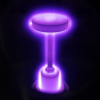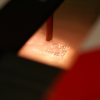Plasmas - Processes - Surfaces group

Low presure DC diode N2-H2-Ar plasma

Plasma electrolytic oxidation

Microwave plasma torch at atmospheric pressure
Last publications
- Modeling of plasma nitriding and thermal annealing processes of austenitic stainless steel
Arvaidas Galdikas, Paulius Andriūnas, Thierry Czerwiec, Grégory Marcos, Teresa Moskaliovienė
Physica B: Condensed Matter, 2025, 714, pp.417487. ⟨10.1016/j.physb.2025.417487⟩ - Porous nitrogen-doped TiO2/graphene oxide derived from H2N-MIL-125(Ti)/graphene oxide composites as highly efficient visible light active photocatalysts for the degradation of dyes and carbamazepine
Askar Bakhadur, Halima Alem, Vincent Carré, Thomas Gries, Lavinia Balan, Jean-Louis Cantin, Ghouti Medjahdi, Zhandos Orazov, Bolat Uralbekov, Raphaël Schneider
Applied Surface Science, 2025, 714, pp.164466. ⟨10.1016/j.apsusc.2025.164466⟩ - Copper substitution in lanthanum-deficient LaFeO3 perovskites for enhanced photoelectrochemical solar hydrogen production
Vincent Guigoz, Stéphanie Bruyère, Sylvie Migot, Raphaël Schneider, Thomas Gries
International Journal of Hydrogen Energy, In press, 148, pp.150072. ⟨10.1016/j.ijhydene.2025.150072⟩
Presentation
The group Plasmas-Process-Surfaces (PPS) is interested in non-equilibrium low temperature plasmas together with their interaction with material surfaces. The scientific approach combines expertise in plasma diagnostics with competences in material science and engineering. Prime objective aims at investigating the interaction of the plasma with the surface for applications in various industrial domains like transport, energy, mechanics, and biomedical for instance.
The strategy consists in carrying out fundamental studies of the plasmas in order to describe and understand the mechanisms of functionalization of new alloys synthesis at the micro- or nanoscale.
The strength of the PPS group relies on the join expertise in both material science and plasma physics. A wide fleet of experimental rigs in plasma sources, plasma diagnostics tools, and surface characterization facilities benefits all the team members.
Leaning also on the common facilities available at IJL for material elaboration and characterization, the research activities are spread over two main topics closely linked by transverse skills in plasma diagnostics:
- high pressure discharges, including atmospheric pressure plasmas and discharges in or in contact with liquids
- plasma-assisted surface processing for transport and energy applications
The group develops and maintains collaborations with many academics and industrial partners in France and abroad.
Research topics
High pressure discharges, including atmospheric pressure plasmas, discharges in or in contact with liquids
For many years, PPS researchers and engineers have been interested in atmospheric and sus-atmospheric pressure discharges. This is particularly the case of discharges in liquids where the pressure can be as high as several hundred bars. Under such very high-pressure conditions, collision processes strongly perturb the plasma behaviour. The study of these plasmas hence requires the development of original diagnostics tools and appropriate theories.
Plasmas in liquids of tiny size (<< 1 mm) are created by short duration high voltage pulses (typ. < 100 ns). Consequently, these discharges exhibit strong gradients (in time and space) of temperature, pressure and density, together with the development of shock waves and gas bubbles. The description of these plasmas therefore requires taking into account the dynamics of the liquid under the effect of the plasma. Because of the very high heating and cooling rates (> 107 K/s), the temperature of the electrode can reach several thousands of Kelvin very locally and over very short time. The resulting modifications in the material are therefore used to perform specific surface treatments :
- plasma electrolytic oxidation (PEO) is an environmentally friendly process that can advantageously replace conventional anodising to grow protective ceramic layers (e. g. Al2O3, MgO, TiO2) onto light metallic alloys. Micro-discharges that develops over the sample surface because of the dielectric breakdown favours the in depth oxidation. The incorporation of nanoparticles into the layers via the electrolyte makes it possible to extend the range of final functional properties. PEO is an innovative process with many applications in the field of transport (lightening of structures, wear and corrosion resistance) or biomedical (biocompatible treatment of implants and orthopedic prostheses)
- nanomaterial synthesis is achived by nanosecond pulsed discharges ignited in between two electrodes immersed in a dielectric liquid. The appropriate choice of electrode material and liquid, coupled with the discharge breakdown conditions, makes it possible to synthesize new materials at the nano scale with new properties for catalysis or photonics applications.
Dielectric barrier discharges are investigated for their potential in surface functionalization. Research work focuses on hybridation and functionalization of MOF materials (Metal Organic Frameworks) for their applications in hydrogen storage.
A particular interest is brought in the understanding of the physico-chemical mechanisms that occur, during the discharge pulse and the time afterglow, between the DBD-plasma and the processed material in the form of powder. Investigating the interactions of dielectric barrier discharges, in this case with MOFs, is nowadays essential to propose a fine and effective control of this type of plasma process at atmospheric pressure.
Projects:
- ANR CAMFRE (2021-2025)
- ANR SYNERGY (2021-2024)
- ICEEL Soprodsyse (2019-2022)
- PHC Pavle Savic (2020-2022)
Thesis:
- Corentin Tousch (2020-2023)
- Aymane Najah (2018-2021)
- Anna Nominé (2020-2023)
- Ronny Jean-Marie Désirée (2021-2024)
- Lucas Magniez (2022-2025)
Partnerships and collaborations:
- Amphenol-Socapex
- CRITT TJFU
- Faculty of Physics University of Belgrade (Serbie)
- GéoRessources
- ICSM
- IRT M2P
- ITMO University St Petersbourg (Russie)
- LABEX DAMAS
- LEM3
- Radiall
- Souriau-Eaton
- TE-connectivity
Plasma-assisted surface processing for transport and energy applications
The PPS group is interested in societal and economical challenges, namely hydrogen production and storage, reducing the energy consumption in transport industry (automotive, aeronautics), the sustainability of materials, and the development of safer and environmentally friendly processes. To address these challenges, PPS team develops and studies various plasma assisted surface processes at low or moderate pressure:
- diode DC, pulsed, DECR → thermochemical treatments
- magnetron, HiPIMS, microwave, DECR → coatings and thin films
- microwave, DECR → etching / surface patterning
- microwave plasma afterglow, RF, DBD, arc → surface functionalization
Research works aim at providing the processed surfaces with improved or even unprecedented usage properties. Wear and corrosion resistance, optical or catalytic properties, wettability, etc. are examples of the targeted properties.
Surface patterning (combined or not combined with thermochemical treatment) is one of the major concerns of the group. Plasma processes like sputtering, diffusion treatment or etching are successfully developed to structure or pattern the surface of steels (alpha-iron, austenite, martensite). From a fundamental point of view, the study of the physical phenomena resulting from these treatments (anisotropic diffusion and deformation, uplift, etc.) will lead to major scientific advances in the surface processing domain. Combined with an improved sustainability, this innovative approach benefits a wide range of applications in self-cleaning, anti-icing, drag reduction, friction, thermal exchanges, biotechnologies, etc.
The deep investigation of the plasma parameters and properties is essential for mastering surface treatments. Therefore, the team implements process engineering approaches through the coupling between the diagnostics of plasmas and the characterization of the modified surfaces.
Projects:
- ITN Flowcamp (2018-2021)
- ICEEL Costhedi (2017-2021)
- Interreg PULSATEC (2018-2022)
- ANR SPOT (2017-2022)
- ICEEL Clearer (2020-2023)
- ICEEL Textir (2020-2023)
- FRCR HyPE (2021 – 2023)
- ANR Dropsurf (2021 – 2024)
- ANR Verglas (2022 – 2025)
Thesis:
- Majed Awaji (2022-2025)
- Dimitri Boivin (2018-2022)
- Martyna Charyton (2018-2021)
- Feriel Laourine (2018-2021)
- Arthur Maizeray (2020-2023)
Partnerships and collaborations:
- LABEX DAMAS
- AGC Europe (Belgique)
- Amer-Sil (Luxembourg)
- LUE ULHyS
- C2N
- CRITT TJFU
- Federal University of Santa Catarina (Brésil)
- IMN
- IRT M2P
- LCPME
- LEM3
- LEMTA
- LRGP
- PPrime
- SILSEF
- UTN-National University of Technology (Argentine)
Know-how
Plasma physics and chemistry
- High and low pressure plasmas
- Plasmas in liquids
- Plasmas diagnostics (high resolution optical emission spectroscopy, laser spectroscopy, Langmuir probes, mass spectrometry, FTIR spectroscopy, ultra-fast video recording, micro-wave interferometry)
Plasma surface interactions
- Surface functionalization, coatings (PVD, PACVD, grafting, etching, cleaning, etc.)
- Thermochemical treatments (nitriding, carburizing, boriding, etc.)
- Plasma-assisted surface patterning
Nanomaterial synthesis by plasma
- 2D materials
- Nanoparticles made of non-miscible elements
- Nanowires and nanotubes
Innovation and technology transfer
- Process and system for the submicron structuring of a substrate surface
T. Belmonte, T.S. Amaral, T. Gries, C. Noël, R.P. Cardoso, patents WO2015052396A1, EP3055248B1, US20160247665A1, JP2017501558A, FR3011540B1
- Graphite exfoliation and graphene functionalization by plasma process in liquid
S. Cuynet, M. Ponçot, S. Fontana, A. Letoffé, T. Belmonte, G. Henrion, C. Hérold, I. Royaud, Patent FR2020479 - Exfoliation and graphene functionalization by plasma in liquid.
S. Fontana (leader), S. Cuynet, M. Ponçot, A. Letoffé, T. Belmonte, G. Henrion, C. Hérold, I. Royaud, Maturation project 2021, SATT SAYENS
Members
CNRS researchers
- Thierry BELMONTE
- Stéphane CUYNET
- Thomas GRIES
- Truong Son NGUYEN
Professors, assistant professors
- Mohammed BELMAHI
- Jamal BOUGDIRA
- Thierry CZERWIEC
- Ludovic DE POUCQUES
- Robert HUGON
- Julien MARTIN
Technical and support staff
- Grégory MARCOS
- Cédric NOEL
- Régis PEIGNIER
PhD students
- Claire BOUDAT
- Amani GHARBI
- Arthur HELLE
- Thai-Ha HOANG
- Loann JACOB
- François ROUSSEAU
Emeritus
Publications
Contact
Head of the group
Grégory MARCOS
gregory.marcos@univ-lorraine.fr
+33 (0) 3 72 74 24 91
Nancy-Artem
Institut Jean Lamour
Campus Artem
2 allée André Guinier - BP 50840
54011 NANCY Cedex
